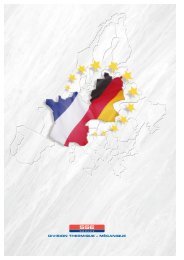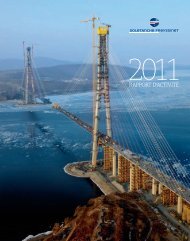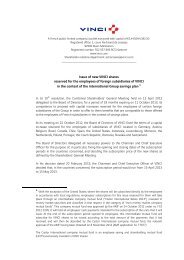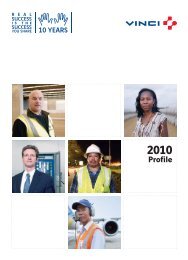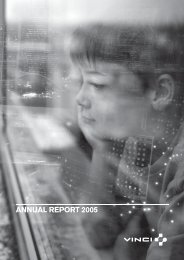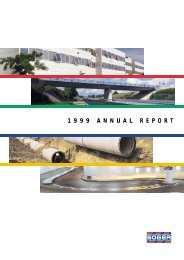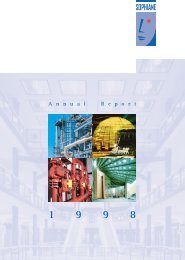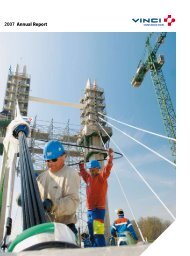VINCI - 2008 annual report
VINCI - 2008 annual report
VINCI - 2008 annual report
Create successful ePaper yourself
Turn your PDF publications into a flip-book with our unique Google optimized e-Paper software.
Report of the Board of Directors<br />
2.3 Market risks (interest rate, currency and equity)<br />
Because of its level of borrowings, <strong>VINCI</strong> is exposed to changes in interest rates (mainly in the eurozone) in connection with its net fl oating-rate<br />
debt and to changes in the spreads applied by lenders. <strong>VINCI</strong> is also exposed to currency risk in connection with its activities outside France and<br />
to fi nancing in foreign currencies. However, approximately 75% of <strong>VINCI</strong>’s activities in international markets is conducted through subsidiaries<br />
operating in the eurozone. The only debt issued by a Group entity in a currency other than its <strong>report</strong>ing currency was repaid in March <strong>2008</strong>. In<br />
consequence, <strong>VINCI</strong>’s exposure to currency risk remains limited. Management of interest rate and currency risks is explained in Notes 23.1 and<br />
23.3 to the consolidated fi nancial statements (on pages 238 to 243).<br />
Investment vehicles used to manage cash surpluses are mainly monetary UCITS, negotiable debt securities and bank deposits. Equity risk is<br />
described in Note 23.2 to the consolidated fi nancial statements on page 242.<br />
2.4 Impact of Public Private Partnerships (PPPs) on the Group’s fi nancial situation<br />
The impact of a PPP project on the Group’s fi nancial situation, in particular regarding the interest rate and liquidity risks, is one of the items taken<br />
into account in responding to an invitation to tender.<br />
Depending on their size, such projects are submitted to either the holding company’s or the division’s Risk Committee for examination and<br />
approval. The largest PPP projects are carried out through special purpose entities, dedicated solely to realising the project. These vehicles are<br />
fi nanced by loans made directly to the project company, with no recourse against the shareholder, backed by the future income stream with the<br />
objective of minimising the capital outlay.<br />
Capital contributions in PPP projects are therefore limited, generally to a maximum of 20% of capital invested. The impact on the Group’s liquidity<br />
is therefore slight.<br />
Debt raised by project companies is hedged at fi xed and / or capped fl oating rate for a very large proportion, generally more than 80%. The proportion<br />
hedged generally corresponds to commitments made to lenders. The impact of interest-rate fl uctuations on PPPs is therefore limited.<br />
3. Legal risks<br />
Given the diversity of its activities and geographical locations, the Group operates within a complex legal and regulatory environment governed<br />
by the place where the service is provided and the sector involved. In particular, rules relating to public and private-sector contracts and tenders,<br />
competition and market concentration, commercial, fi nancial and stock market law are applicable. The Group’s activities could lead it to being<br />
held civilly or criminally liable, in France and in foreign countries. Civil liability risks relate in particular to construction companies. The fi nancial<br />
risks relating to any invoking of Group companies’ civil liability are covered by insurance policies described in paragraph 5 below.<br />
It should also be noted that, with respect to concession operations, in particular in France, the Group is dependent on public authorities. Under<br />
the French law applicable to government bodies, these can – subject to compensation – alter the terms and conditions of outsourced public<br />
service contracts during their performance.<br />
Information on the principal disputes in which the Group is involved can be found in Note F to the consolidated fi nancial statements, on page<br />
249. The policy on taking provisions in respect of disputes is referred to in a note to the consolidated fi nancial statements on page 185 and their<br />
amount is disclosed on pages 226 and 228.<br />
The Report of the Chairman includes a paragraph on compliance with laws and regulations in force.<br />
4. Environmental, industrial and technological risks<br />
4.1 Economic risks and opportunities associated with climate change<br />
Only one <strong>VINCI</strong> facility is concerned by France’s national greenhouse gas quota scheme (PNAQ II): CIFC’s plant (part of Eurovia) at Fos-sur-Mer<br />
near Marseilles, for 190,086 tonnes. In accordance with the law, an approved inspector validates the emissions before 15 February each year.<br />
Emissions at CIFC’s plant amounted to 170,112 tonnes of CO 2 in 2006, 158,661 tonnes in 2007 and 162,658 tonnes in <strong>2008</strong>. 18,000 tonnes of<br />
CO 2 quota were sold in <strong>2008</strong>.<br />
<strong>VINCI</strong> divides climate change risks into four categories, each one being the subject of a diff erent approach in terms of economic risks and opportunities:<br />
– physical risks such as damage or project delays due to the increasing number of climate events;<br />
– regulatory risks caused by the introduction of more stringent international, European and national regulations aimed at reducing greenhouse<br />
gas emissions;<br />
– competition risks caused by a possible increase in customer demand for more fuel-effi cient products and processes;<br />
– the risks of no action being taken to combat climate change.<br />
4.2 Industrial and environmental risks<br />
<strong>VINCI</strong> has low exposure to industrial and environmental risks.<br />
Some of Eurovia’s activities – which are closely regulated – have characteristics similar to those of industry and can therefore be exposed to these<br />
risks, which are limited and well identifi ed.<br />
– Binder plants: the use or manufacture of products that are potentially hazardous to the environment is subject to continuous monitoring and<br />
internal inspections by Eurovia’s quality, safety and environment managers.<br />
– Coating plants: the setting up of an environmental regulation monitoring group for the industrial sites allows managers to takes the necessary<br />
action to ensure continuing compliance with regulations; regular and unannounced external inspections to analyse products and measure the<br />
quantities in stock ensure the plants comply with regulations.<br />
106 <strong>VINCI</strong> __ <strong>2008</strong> ANNUAL REPORT




